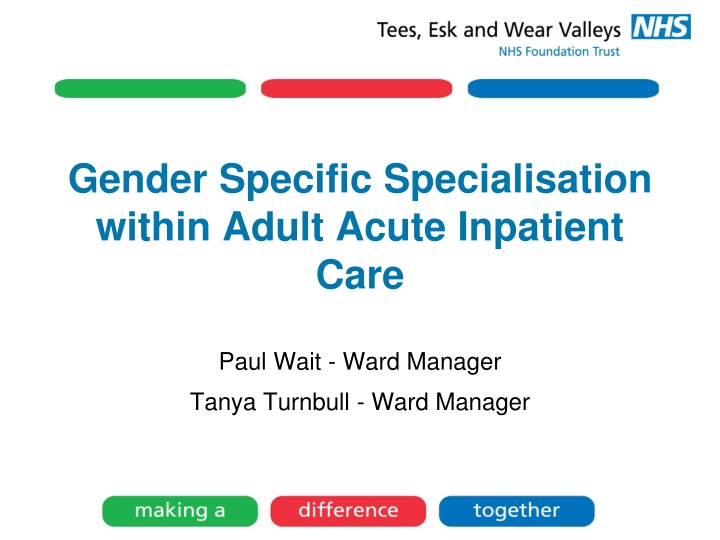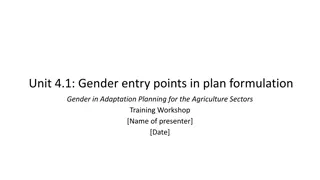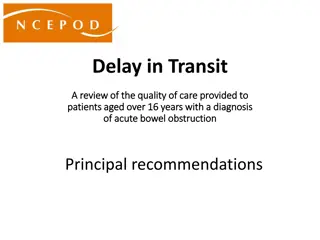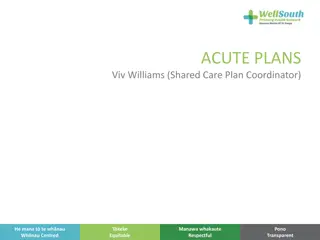Gender-Specific Specialisation in Adult Acute Care
Addressing gender-specific healthcare needs in adult acute inpatient settings, focusing on factors affecting men and women's health, interventions for promoting well-being, and the impact of psychotropic medications.
Download Presentation

Please find below an Image/Link to download the presentation.
The content on the website is provided AS IS for your information and personal use only. It may not be sold, licensed, or shared on other websites without obtaining consent from the author.If you encounter any issues during the download, it is possible that the publisher has removed the file from their server.
You are allowed to download the files provided on this website for personal or commercial use, subject to the condition that they are used lawfully. All files are the property of their respective owners.
The content on the website is provided AS IS for your information and personal use only. It may not be sold, licensed, or shared on other websites without obtaining consent from the author.
E N D
Presentation Transcript
Gender Specific Specialisation within Adult Acute Inpatient Care Paul Wait - Ward Manager Tanya Turnbull - Ward Manager
Aims and Objectives: Why have gender specific care? Issues that may affect women s health? Issues that may affect men s health? What interventions can we use to promote health in men and women? Do inpatient ward offer therapeutic and occupational activity? Protected Engagement Time.
What issues affect womens health?
Spend 5 minutes talking to the person next to you and list issues affecting women's health.....
General Points - Women Menstrual cycle Fertility Childbirth (pre and postnatal) Childcare/families Menopause Gender specific diseases, e.g. ovarian cancer, endometriosis
Impact of psychotropic medications Sexual identification Sexual health Body image/self-esteem Weight gain Vulnerability and safety
Menstrual Cycle Aetiological Factors in Psychiatric Disorders?? Anecdotal evidence suggests that many women experience symptoms related to changes in the menstrual cycle. Wittchen et al. (2002) estimate that at least one premenstrual symptom is experienced regularly across cycles by approximately 80% of women. Targum et al. (1991) found 47% of psychiatric admissions (with varying diagnoses) in a sample of 51 women took place in the para-menstrual phase.
Premenstrual dysphoric disorder (PMDD) PMDD is an extreme variant on the continuum of premenstrual symptoms with reported prevalence rates that range from 3 8% (Halbreich, Borenstein, Pearlstein, and Kahn, 2003). Although PMDD was originally conceptualized as a depressive disorder, premenstrual anxiety is a common symptom reported among affected women (Vickers and McNally, 2004).
Does oestrogen have a protective effect in schizophrenia?? A Cochrane Review (Chua et al. 2010) investigated whether oestrogen may have a protective effect for schizophrenia Women are more vulnerable to psychotic illness in the period after birth and menopause As low oestrogen levels mark these periods could oestrogen be effective as a treatment for schizophrenia?
Cochrane Review concludes Adjunctive oestrogen with or without progesterone does not appear to offer convincing advantages over placebo . BUT absence of evidence is not evidence of absence. More research is needed!
Medications and Menstrual Cycle The neurotransmitter dopamine inhibits the release of the hormone prolactin. Dopamine antagonists (antipsychotics) therefore increase plasma prolactin levels. Maudsley Prescribing Guidelines (11thedition) advise that while all antipsychotics cause measurable changes in prolactin, Clozapine, Olanzapine, Quetiapine, Aripiprazole and Ziprasidone do not increase levels above normal range at standard doses.
Persistent elevation of plasma prolactin has adverse consequences, including Sexual dysfunction (but other drugs + aetiology of psychiatric illnesses are associated with this). Reductions in bone mineral density. Menstrual disturbances. Breast growth and galactorrhoea. Suppression of the hypothalamic-pituitary-gonadal axis 22. Possible increased risk of breast cancer. Wieck and Haddad (2003) argue that hyperprolactinaemia is a neglected part of antipsychotic treatment and that clinicians should pay more attention to this problem.
What issues affect mens health?
Spend 5 minutes talking to the person next to you and list issues affecting men's health.....
General Points - Men Heart Disease Diabetes Testicular Cancer Family Life Increased Alcohol and Substance use Poor engagement with services, including GP
Impact of psychotropic medications Sexual identification Sexual health Confidence/self-esteem Weight gain Vulnerability and safety
Sexual Problems in Men with Mental Health Conditions Antidepressants Antipsychotics
Sexual Side Effects of Antidepressants May include: Altered desire Orgasmic dysfunction Erectile and ejaculatory problems Relatively common side effects Implications re quality of life and medication concordance
Antipsychotic drugs are associated with many sexual side effects including: Penile erection Orgasm Libido Retrograde ejaculation Sexual arousal Overall sexual satisfaction Implications re quality of life and medication compliance
Sexual Side Effects Cochrane Reviews Cochrane Review (Rudkin et al., 2004) found that the addition of Sildenafil (Viagra) may be effective in improving antidepressant-inducted erectile dysfunction. Cochrane Review (Schmidt et al., 2012) concludes Sildenafil may be a useful option in the treatment of antipsychotic-induced sexual dysfunction in men with schizophrenia . Switching to Olanzapine may improve sexual functioning in men and women. More research is needed!
What interventions can we use to promote women s health?
Specific Interventions used on Tunstall Ward, North Durham Aspire (voluntary service) Previously known as Bridge, these volunteers come to the ward twice a week and offer a drop in session where they offer alternative therapies such as: Relaxation Reflexology Reiki therapy Massage Hairdressing
Aspire also provide: Female patients are offered information on relevant courses or training post discharge (e.g. NVQs, creative writing, counselling/bereavement support). Informal chats with Aspire ladies can identify areas where patients could benefit from further support (e.g. motivation, self-esteem and confidence) these issues can then be targeted specifically by the MDT. Aspire volunteers also offer courses within the community for Tunstall patients who have been discharged.
What interventions can we use to promote men s health?
Specific Interventions used on Farnham Ward, North Durham Farnham: Associate Practitioner- Activity Coordinator: Relaxation Mindfullness Newspaper Groups Board Games Quiz's One-to-One Sessions CBT: Group/Individual Art Group Table Tennis
Farnham: Future Developments Development of ward based Acupuncture Hearing Voices Group
Personal Account. As part of my new role, I have worked hard to improve the way I work and the service I work within. I have worked closely with the clients in my care and have created a good range of both therapeutic and ward based activities for them to choose from. I hope that these groups and activities are stimulating, interesting, and enjoyable. The aim is to help keep clients active, reduce their levels of isolation, boost confidence and self esteem, whilst increasing their concentration and coping skills. I hope that clients can also utilise these skills in the future . Steve Gibson Associate Practitioner
Interventions to promote health in men and women
Physical Exercise The research Cochrane Review (Rimer et al. 2012) concluded that Exercise seems to improve depressive symptoms in people with a diagnosis of depression when compared with no treatment or control Cochrane Review (Gorczynski and Faulkner, 2010) found that regular exercise programmes are possible in people with schizophrenia and that exercise can have healthful effects on both the physical and mental health and well-being of individuals with schizophrenia .
Exercise An Inpatient Approach Both wards make extensive use of the on-site gymnasium. The dedicated Fitness Instructor accepts gym referrals for clients with the following health conditions: Angina Arthritis Back Pain Chronic Fatigue Hypertension Osteoporosis
Stroke Obesity Diabetes (types 1 and 2) COPD Asthma Anxiety/depression 2 Health Care Assistants have recently completed gym instructors courses to support patients in attending the gym out of hours (after 5pm and at week ends).
Exercise and further activities The Intensive Support Team offer many activity and therapeutic based group interventions : Badminton Football Gardening Walking groups Making Changes Group Creative writing Art group Card making Knitting/sewing
Intensive Support Team also offer: Bingo Breakfast group Self esteem group Volunteer Italian Chef works every Tuesday and assists and educates ladies with healthy eating the Italian way . Research shows that activities are a key component of alleviating patient boredom (Steele, R; Henderson, P; Lennon, F and Swinden, D (2013) A critical literature review exploring boredom in inpatient psychiatric services as part of a clinical librarian project. Advances in Psychiatric Treatment.
Gender specific medication information needs Both wards offer Weekly 30 minute Medication information drop in sessions with Clinical pharmacists. Individual appointments are also be offered during the week.
Physical health monitoring Baseline screening on admission Dedicated drop-in clinics for Monitoring weight/BMI Measuring blood pressure Monitoring blood sugars (where necessary) Outcome of drop-in clinic informs next steps with MDT (e.g. gym) Regular interventions Urine screening Smoking cessation referrals Physical observations Drug screening Pregnancy tests and targeted support
Physical Health Targeted Support - Physiotherapy Close working with inpatient physiotherapist team for clients with conditions such as: Back, shoulder or knee problems Musculo-skeletal injuries Falls Neurological, balance and walking problems Pain Low mood and depression Anxiety Stress
Integrated approach to health promotion Both wards identify lead staff to provide both general health promotion and gender specific interventions: Sexual health Smoking cessation Diabetes interventions Infection prevention and control Education on healthy eating Dual diagnosis PTSD/Veteran Health Pregnancy screening Use of menstrual cycle diaries
What is PPT? A means of organising ward activity that emphasises the relationship between nurses and patients. Involves recognition that a period of time for interaction needs boundaries & that other duties impinge on this. No guidance exists as to how it should be carried out. Acute Care Collaborative: Government funded initiative with a focus on reducing violence and substance misuse on wards: identified some aspects of PPT.
Guidance from Acute Care Collaborative: PPT should take place at regular times, minimum once per week, and up to daily. Staff are relieved of their administrative duties, and out of the office. Ward is closed to visitors, and other professional staff.
Background to PPT Problematic issues highlighted by literature on acute inpatient setting in the UK: Lack of contact between staff and patients (predominantly nurses) Lack of therapeutic interventions Boredom Feeling unsafe
Lack of evidence based initiatives of addressing reported problems. Missing Patient Strategy identifies that helps improve the balance between office based activity and the opportunity for nurses to offer therapeutic activity. Tidal model (Barker, 2001) and Refocusing Model (Bowles et al, 2002): examples of initiatives intended to improve therapeutic interactions in wards, but lacking robust evidence base. Interest in PPT has stemmed from anecdote, rather than evidence.
Group Work In Pairs: Consider the potential benefits of PPT for patients and nursing staff and wider MDT. In order to embed this into practice, what support would be needed?
Potential Benefits of PPT Inexpensive or cost neutral to implement. No staff training or extra resources required, though considerations need to be given to up skilling staff regarding additional therapeutic training. Rapid uptake is possible. Supports nurses in having protected time to nurse .
PPT Hypothesis Improve patient satisfaction and promote therapeutic relationships. Promote nurses job satisfaction and decreases levels of stress and burnout. Lead to a calmer environment on wards. Assists in gathering additional information for patients that may otherwise be missed.
Group Work In Pairs: Identify any limitations to and difficulties in embedding PPT. Devise an action plan, proposal or mission statement which will assist with PPT s introduction onto acute inpatient mental health wards.
How it actually works Promotes leaner processes: all MDT s take place 10am-12:30pm (medics can see patients in afternoon). PPT takes place on both wards at 15:00-16:00hrs Monday-Friday. The ward ceases any other activity. The ward office is locked.
A sign is placed at the nursing station. A floor nurse is allocated to answer the phone, signpost and act as liaison. ALL nursing staff participate in PPT. A sign is placed on the ward door, notifying patients visitors that it is PPT and to call back at 16:00hrs.























